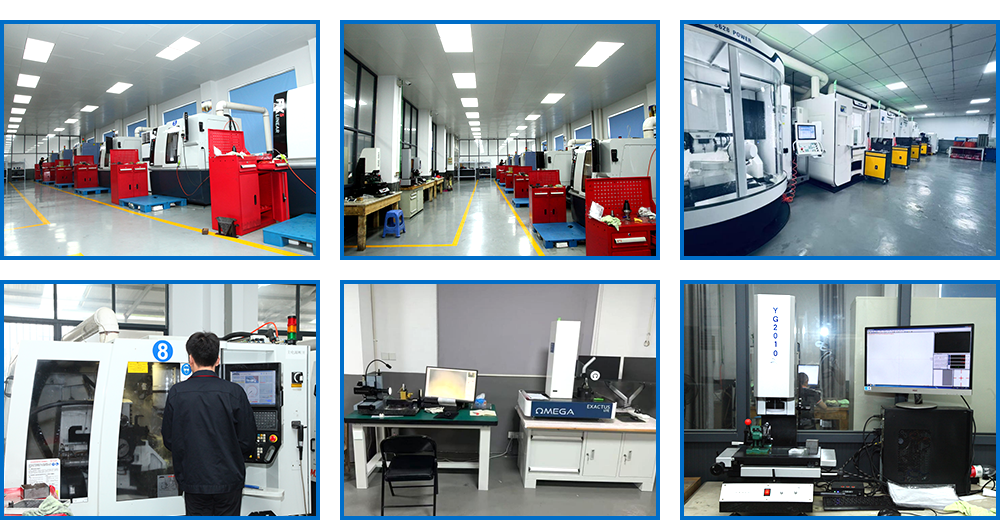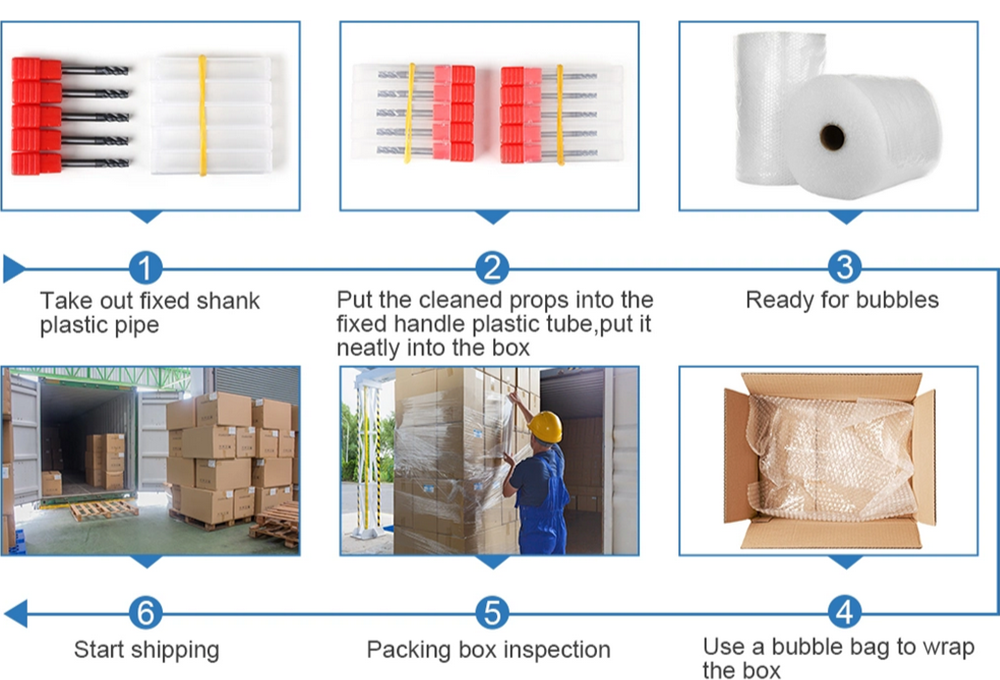English
- All
- Product Name
- Product Keyword
- Product Model
- Product Summary
- Product Description
- Multi Field Search
| SKU: | |
|---|---|
| Availability: | |
| Quantity: | |
HRC65 Carbide End Mills
We specialize in manufacturing high-performance HRC65 coated milling cutters. These tools are made from premium stainless steel and are designed to handle hard materials with a hardness of up to HRC60. The advanced coating on the cutters not only improves wear resistance but also enhances cutting efficiency, reducing heat generation and extending tool life. Our HRC65 milling cutters are ideal for high-speed milling applications and offer precision, durability, and reliability, making them the perfect choice for demanding machining tasks.
Materials Suitable for Machining
Precision and semi-precision machining of materials such as mold steel (up to HRC55) and cast iron.
Show Details

Specitications
| SIZES(D*fL*sD*L) | |
| D1*3*D4*50L | D5*(13/20/25)*D5*(50775/100)L |
| D1.5*4.5*D4*50L | D6*(15/24/30)*D6*(50775/100)L |
| D2*6*D4*50L | D8*(20/30/35*D8*(50/75/100L |
| D2.5*7.5*D4*50L | D10*(25/40)*D10*(75/100)L |
| D3*9*D4*50L | D12*(30/45)*D12*(75/100)L |
| D3*(9/12/15*D3*(50/75/100L | D14/D16/D18/D20/D25*100L |
| D4*(10/16/20)*D4*(50/75/100)L | D6/D8/D10/D12/D14/D16/D18/D20*150L |
SUPSTEED’s HRC65 End Mills redefine high-hardness machining with nano-blue coating technology, delivering 3× longer tool life than conventional TiAlN-coated alternatives. Engineered for hardened steels (up to 65 HRC), stainless steel, and superalloys, these tools combine extreme wear resistance with thermal stability up to 900°C. The proprietary coating reduces friction by 40%, enabling smoother chip evacuation and minimizing heat-induced workpiece deformation.
Featuring an unequal helix design (37°/45°) and variable pitch, these end mills eliminate harmonic resonance during high-speed machining. This reduces chatter by 60%, allowing aggressive feeds in deep-pocket milling and contouring of aerospace components and injection molds. The reinforced corner radius (0.2mm–0.5mm) prevents edge chipping even under interrupted cuts.
Ultra-fine carbide substrate (0.6μm grain size): Maximizes fracture resistance while maintaining razor-sharp edges.
4-flute configuration: Optimized for balance between chip clearance and stability in finishing operations.
±0.002mm tolerance: Laser-verified runout ensures mirror finishes (Ra ≤0.2μm) and tight tolerance compliance
Ideal for:
Mold & Die: Deep-cavity machining of P20, H13 tool steels.
Aerospace: Slotting Inconel 718 and Ti-6Al-4V.
Medical: Micro-milling cobalt-chrome implants
| Parameter | Specification |
|---|---|
| Diameter Range | 1–20 mm (shank: 4–20 mm) |
| Coating | Nano Blue (AlCrN + SiN multilayer) |
| Flute Length | 3–75 mm |
| Helix Angle | 37°/45° unequal |
| MOQ | 10 pieces (OEM/ODM supported) |
Why SUPSTEED?
Factory Direct: ISO 9001-certified production with full traceability.
3-Year Warranty: Coverage against manufacturing defects.
Tech Support: Application-specific parameter optimization guides included.
Clients Good Feedback

Factory

Service Introduction

Logistics Package

FAQ
Frequently Asked Questions (FAQ): End Mills
Q1: What is an end mill, and how does it differ from a drill bit?
A1: An end mill is a rotary cutting tool used in milling machines to remove material from a workpiece. Unlike drill bits (which cut axially), end mills cut laterally and can perform plunge cuts, slotting, contouring, profiling, and face milling. They feature cutting edges (flutes) along the sides and bottom, enabling multi-directional cutting.
Q2: What factors should I consider when selecting an end mill?
A2: Key factors include:
Material: Workpiece material (e.g., aluminum, steel, titanium, composites) dictates tool coating and geometry.
Operation: Roughing, finishing, slotting, or profiling require specific end mill designs (e.g., variable helix for chatter reduction).
Coating: Coatings like TiAlN (for heat resistance) or ZrN (for non-ferrous metals) enhance tool life.
Flute Count: Fewer flutes (2–3) for chip evacuation in soft materials; more flutes (4–7) for stability in harder metals.
Tool Geometry: Helix angle, edge prep, and corner radius impact performance.
Q3: How do coatings like TiAlN or AlCrN improve end mill performance?
A3: Coatings reduce friction, dissipate heat, and prevent wear:
TiAlN (Titanium Aluminum Nitride): Ideal for high-temperature machining (e.g., steel, stainless steel).
AlCrN (Aluminum Chromium Nitride): Superior hardness for abrasive materials (e.g., cast iron, Inconel).
Uncoated: Best for non-ferrous metals (e.g., aluminum, copper) to prevent material adhesion.
Coated end mills last 3–5x longer than uncoated tools in demanding applications.
Q4: Why does flute count matter, and how do I choose?
A4: Flute count affects chip evacuation, tool strength, and finish quality:
2–3 Flutes: Maximize chip space for soft, gummy materials (e.g., aluminum, plastics).
4 Flutes: Balance strength and finish for general-purpose steel machining.
5+ Flutes: Produce finer finishes in hard metals (e.g., titanium) but limit chip space.
Note: Higher flute counts reduce vibration but require optimized chip control.
Q5: What is the difference between a square end, ball nose, and corner radius end mill?
A5:
Square End: Sharp 90° corners for precise slots, pockets, and vertical walls.
Ball Nose: Rounded tip for 3D contouring, molds, and complex curved surfaces.
Corner Radius (Bull Nose): Small radius on edges increases tool strength and reduces chipping (ideal for high-stress machining).
Tip: Use corner radius end mills for roughing and ball nose tools for finishing intricate geometries.
FAQ 1: Beyond Hardness: What substrate properties besides hardness are critical for high-performance end mills, and why?
Answer: While hardness is vital, fracture toughness and thermal stability are equally crucial. Toughness prevents micro-chipping during interrupted cuts (e.g., milling slots), while thermal stability maintains hardness at high temperatures (e.g., machining aerospace alloys). Ultra-fine carbide grain structures optimize both, preventing premature tool failure.
FAQ 2: Why might two end mills with identical geometry & coating perform drastically differently?
Answer: Micro-geometry variations (e.g., cutting edge hone radius, flute surface finish) and coating adhesion quality are key invisible factors. A smoother flute reduces chip welding, while a precisely honed edge (e.g., 5–10µm vs. 20µm) enhances edge strength for hardened materials. Poor coating adhesion causes flaking under thermal stress.
FAQ 3: How does end mill flute geometry influence chip evacuation beyond just chip volume?
Answer: Flute design dictates chip flow dynamics and tool vibration. High-efficiency geometries (e.g., variable pitch/flute) disrupt harmonic vibrations, reducing chatter. Optimized helix angles (e.g., 35°–45°) balance shear force and chip lift, preventing recutting—critical in deep-pocket machining where clogging causes breakage.
FAQ 4: What hidden costs make "cheap" end mills more expensive long-term?
Answer: Tool life variability, scrap/rework rates, and machine downtime dominate hidden costs. Inconsistent tool life disrupts production scheduling. Poor surface finish or dimensional accuracy from low-grade tools increases scrap. Frequent tool changes reduce spindle utilization. Premium tools lower cost-per-part despite higher initial price.
FAQ 5: How are end mills evolving for additive/non-traditional manufacturing?
Answer: End mills now address hybrid manufacturing (additive + subtractive):
Specialized coatings (e.g., DLC) resist abrasive sintered metals.
Geometry for support removal: Short-length, high-helix tools access complex AM geometries.
Vibration-dampened designs machine near-net-shape parts with uneven residual stress, minimizing distortion.
HRC65 Carbide End Mills
We specialize in manufacturing high-performance HRC65 coated milling cutters. These tools are made from premium stainless steel and are designed to handle hard materials with a hardness of up to HRC60. The advanced coating on the cutters not only improves wear resistance but also enhances cutting efficiency, reducing heat generation and extending tool life. Our HRC65 milling cutters are ideal for high-speed milling applications and offer precision, durability, and reliability, making them the perfect choice for demanding machining tasks.
Materials Suitable for Machining
Precision and semi-precision machining of materials such as mold steel (up to HRC55) and cast iron.
Show Details

Specitications
| SIZES(D*fL*sD*L) | |
| D1*3*D4*50L | D5*(13/20/25)*D5*(50775/100)L |
| D1.5*4.5*D4*50L | D6*(15/24/30)*D6*(50775/100)L |
| D2*6*D4*50L | D8*(20/30/35*D8*(50/75/100L |
| D2.5*7.5*D4*50L | D10*(25/40)*D10*(75/100)L |
| D3*9*D4*50L | D12*(30/45)*D12*(75/100)L |
| D3*(9/12/15*D3*(50/75/100L | D14/D16/D18/D20/D25*100L |
| D4*(10/16/20)*D4*(50/75/100)L | D6/D8/D10/D12/D14/D16/D18/D20*150L |
SUPSTEED’s HRC65 End Mills redefine high-hardness machining with nano-blue coating technology, delivering 3× longer tool life than conventional TiAlN-coated alternatives. Engineered for hardened steels (up to 65 HRC), stainless steel, and superalloys, these tools combine extreme wear resistance with thermal stability up to 900°C. The proprietary coating reduces friction by 40%, enabling smoother chip evacuation and minimizing heat-induced workpiece deformation.
Featuring an unequal helix design (37°/45°) and variable pitch, these end mills eliminate harmonic resonance during high-speed machining. This reduces chatter by 60%, allowing aggressive feeds in deep-pocket milling and contouring of aerospace components and injection molds. The reinforced corner radius (0.2mm–0.5mm) prevents edge chipping even under interrupted cuts.
Ultra-fine carbide substrate (0.6μm grain size): Maximizes fracture resistance while maintaining razor-sharp edges.
4-flute configuration: Optimized for balance between chip clearance and stability in finishing operations.
±0.002mm tolerance: Laser-verified runout ensures mirror finishes (Ra ≤0.2μm) and tight tolerance compliance
Ideal for:
Mold & Die: Deep-cavity machining of P20, H13 tool steels.
Aerospace: Slotting Inconel 718 and Ti-6Al-4V.
Medical: Micro-milling cobalt-chrome implants
| Parameter | Specification |
|---|---|
| Diameter Range | 1–20 mm (shank: 4–20 mm) |
| Coating | Nano Blue (AlCrN + SiN multilayer) |
| Flute Length | 3–75 mm |
| Helix Angle | 37°/45° unequal |
| MOQ | 10 pieces (OEM/ODM supported) |
Why SUPSTEED?
Factory Direct: ISO 9001-certified production with full traceability.
3-Year Warranty: Coverage against manufacturing defects.
Tech Support: Application-specific parameter optimization guides included.
Clients Good Feedback

Factory

Service Introduction

Logistics Package

FAQ
Frequently Asked Questions (FAQ): End Mills
Q1: What is an end mill, and how does it differ from a drill bit?
A1: An end mill is a rotary cutting tool used in milling machines to remove material from a workpiece. Unlike drill bits (which cut axially), end mills cut laterally and can perform plunge cuts, slotting, contouring, profiling, and face milling. They feature cutting edges (flutes) along the sides and bottom, enabling multi-directional cutting.
Q2: What factors should I consider when selecting an end mill?
A2: Key factors include:
Material: Workpiece material (e.g., aluminum, steel, titanium, composites) dictates tool coating and geometry.
Operation: Roughing, finishing, slotting, or profiling require specific end mill designs (e.g., variable helix for chatter reduction).
Coating: Coatings like TiAlN (for heat resistance) or ZrN (for non-ferrous metals) enhance tool life.
Flute Count: Fewer flutes (2–3) for chip evacuation in soft materials; more flutes (4–7) for stability in harder metals.
Tool Geometry: Helix angle, edge prep, and corner radius impact performance.
Q3: How do coatings like TiAlN or AlCrN improve end mill performance?
A3: Coatings reduce friction, dissipate heat, and prevent wear:
TiAlN (Titanium Aluminum Nitride): Ideal for high-temperature machining (e.g., steel, stainless steel).
AlCrN (Aluminum Chromium Nitride): Superior hardness for abrasive materials (e.g., cast iron, Inconel).
Uncoated: Best for non-ferrous metals (e.g., aluminum, copper) to prevent material adhesion.
Coated end mills last 3–5x longer than uncoated tools in demanding applications.
Q4: Why does flute count matter, and how do I choose?
A4: Flute count affects chip evacuation, tool strength, and finish quality:
2–3 Flutes: Maximize chip space for soft, gummy materials (e.g., aluminum, plastics).
4 Flutes: Balance strength and finish for general-purpose steel machining.
5+ Flutes: Produce finer finishes in hard metals (e.g., titanium) but limit chip space.
Note: Higher flute counts reduce vibration but require optimized chip control.
Q5: What is the difference between a square end, ball nose, and corner radius end mill?
A5:
Square End: Sharp 90° corners for precise slots, pockets, and vertical walls.
Ball Nose: Rounded tip for 3D contouring, molds, and complex curved surfaces.
Corner Radius (Bull Nose): Small radius on edges increases tool strength and reduces chipping (ideal for high-stress machining).
Tip: Use corner radius end mills for roughing and ball nose tools for finishing intricate geometries.
FAQ 1: Beyond Hardness: What substrate properties besides hardness are critical for high-performance end mills, and why?
Answer: While hardness is vital, fracture toughness and thermal stability are equally crucial. Toughness prevents micro-chipping during interrupted cuts (e.g., milling slots), while thermal stability maintains hardness at high temperatures (e.g., machining aerospace alloys). Ultra-fine carbide grain structures optimize both, preventing premature tool failure.
FAQ 2: Why might two end mills with identical geometry & coating perform drastically differently?
Answer: Micro-geometry variations (e.g., cutting edge hone radius, flute surface finish) and coating adhesion quality are key invisible factors. A smoother flute reduces chip welding, while a precisely honed edge (e.g., 5–10µm vs. 20µm) enhances edge strength for hardened materials. Poor coating adhesion causes flaking under thermal stress.
FAQ 3: How does end mill flute geometry influence chip evacuation beyond just chip volume?
Answer: Flute design dictates chip flow dynamics and tool vibration. High-efficiency geometries (e.g., variable pitch/flute) disrupt harmonic vibrations, reducing chatter. Optimized helix angles (e.g., 35°–45°) balance shear force and chip lift, preventing recutting—critical in deep-pocket machining where clogging causes breakage.
FAQ 4: What hidden costs make "cheap" end mills more expensive long-term?
Answer: Tool life variability, scrap/rework rates, and machine downtime dominate hidden costs. Inconsistent tool life disrupts production scheduling. Poor surface finish or dimensional accuracy from low-grade tools increases scrap. Frequent tool changes reduce spindle utilization. Premium tools lower cost-per-part despite higher initial price.
FAQ 5: How are end mills evolving for additive/non-traditional manufacturing?
Answer: End mills now address hybrid manufacturing (additive + subtractive):
Specialized coatings (e.g., DLC) resist abrasive sintered metals.
Geometry for support removal: Short-length, high-helix tools access complex AM geometries.
Vibration-dampened designs machine near-net-shape parts with uneven residual stress, minimizing distortion.
content is empty!